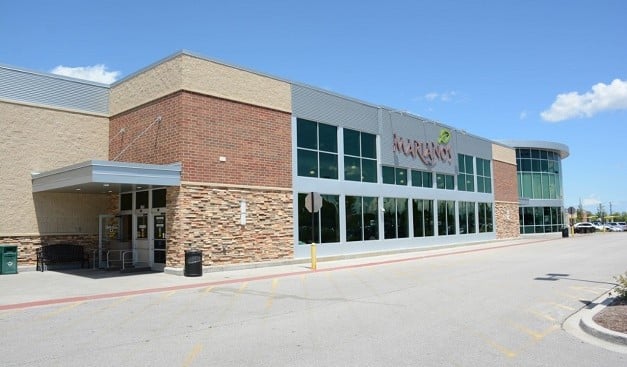
CHICAGO—One of the most striking changes in the US economy in the past few years has been the astonishing rise of e-commerce and its devastating impact on many traditional retailers. But even as venerable companies such as J.C. Penney and Sears have generated headlines by closing hundreds of stores nationwide, others seem immune to internet competition, and that has kept many investors interested in the sector.
“I've been in the business for 25 years, and this is as active as I've seen it, despite all the negative press coverage,” Richard A. Frolik, Oak Brook, IL-based executive vice president of CBRE, tells GlobeSt.com. In 2016, CBRE's Midwest team handled just over $1 billion in retail transactions. Year-to-date, they have already hit $881 million.
And Chicago, which offers better pricing and returns than NY or CA markets, has become a favorite of coastal investors. According to a recent study from Real Capital Analytics, in the first half of this year, the region's retail sector ranked second in attracting buyers, surpassing even Manhattan, the number one market in 2012. In total, Chicago saw $1.536 billion in sales, just behind Los Angeles, which recorded $1.582 billion in sales.
Overall sales volume has declined, Real Capital Analytics also found. Through the end of the second quarter, national sales in the retail sector totaled $32.4 billion, a 16% decrease.
Christian Williams, a senior vice president on CBRE's retail investment team, tells GlobeSt.com that many investors who don't specialize in retail have been scared away by the headlines about big-box retailers in decline. “On the flip side, you have a healthy amount of store openings,” and retail specialists realize that as the big stores close, in healthy markets “there have been retailers ready to backfill that space.”
According to a CBRE Research report on the second quarter, national retail sales rose 4.2% year-over-year. Furthermore, on average, US markets showed no signs of overbuilding. Developers completed 10.8 million square feet of new space, but overall net absorption totaled 13.9 million square feet, with all major segments recording positive movement. That helped push up the average asking rent by 5.9% year-over-year to $17.18—the highest since 2009. The overall availability rate has remained unchanged at 7% for the past three quarters and is 40 bps lower than a year ago.
Grocery-anchored retail centers have become one of the most popular investment targets. These properties continue to attract shoppers, especially if they incorporate innovative concepts. In the Chicago area, Mariano's Fresh Market, a relatively new grocery store brand, quickly took a huge share of the market by offering fresher, healthier food, along with amenities such as wine cafes. And investors responded. Six of its local stores have traded recently, with the CBRE team handling four of these sales.
Frolik is optimistic about what next year will bring. “We are looking at a good, healthy number of listings for next year. As long as interest rates don't dramatically move up, I see pricing holding to today's level.” And regardless of those scary headlines, with the sector's overall stats headed in the right directions, “the people who were sitting on the sidelines may come back.”

CHICAGO—One of the most striking changes in the US economy in the past few years has been the astonishing rise of e-commerce and its devastating impact on many traditional retailers. But even as venerable companies such as J.C. Penney and Sears have generated headlines by closing hundreds of stores nationwide, others seem immune to internet competition, and that has kept many investors interested in the sector.
“I've been in the business for 25 years, and this is as active as I've seen it, despite all the negative press coverage,” Richard A. Frolik, Oak Brook, IL-based executive vice president of CBRE, tells GlobeSt.com. In 2016, CBRE's Midwest team handled just over $1 billion in retail transactions. Year-to-date, they have already hit $881 million.
And Chicago, which offers better pricing and returns than NY or CA markets, has become a favorite of coastal investors. According to a recent study from Real Capital Analytics, in the first half of this year, the region's retail sector ranked second in attracting buyers, surpassing even Manhattan, the number one market in 2012. In total, Chicago saw $1.536 billion in sales, just behind Los Angeles, which recorded $1.582 billion in sales.
Overall sales volume has declined, Real Capital Analytics also found. Through the end of the second quarter, national sales in the retail sector totaled $32.4 billion, a 16% decrease.
Christian Williams, a senior vice president on CBRE's retail investment team, tells GlobeSt.com that many investors who don't specialize in retail have been scared away by the headlines about big-box retailers in decline. “On the flip side, you have a healthy amount of store openings,” and retail specialists realize that as the big stores close, in healthy markets “there have been retailers ready to backfill that space.”
According to a CBRE Research report on the second quarter, national retail sales rose 4.2% year-over-year. Furthermore, on average, US markets showed no signs of overbuilding. Developers completed 10.8 million square feet of new space, but overall net absorption totaled 13.9 million square feet, with all major segments recording positive movement. That helped push up the average asking rent by 5.9% year-over-year to $17.18—the highest since 2009. The overall availability rate has remained unchanged at 7% for the past three quarters and is 40 bps lower than a year ago.
Grocery-anchored retail centers have become one of the most popular investment targets. These properties continue to attract shoppers, especially if they incorporate innovative concepts. In the Chicago area, Mariano's Fresh Market, a relatively new grocery store brand, quickly took a huge share of the market by offering fresher, healthier food, along with amenities such as wine cafes. And investors responded. Six of its local stores have traded recently, with the CBRE team handling four of these sales.
Frolik is optimistic about what next year will bring. “We are looking at a good, healthy number of listings for next year. As long as interest rates don't dramatically move up, I see pricing holding to today's level.” And regardless of those scary headlines, with the sector's overall stats headed in the right directions, “the people who were sitting on the sidelines may come back.”
© Touchpoint Markets, All Rights Reserved. Request academic re-use from www.copyright.com. All other uses, submit a request to [email protected]. For more inforrmation visit Asset & Logo Licensing.








